The Future Of Onboarding Is Continuous
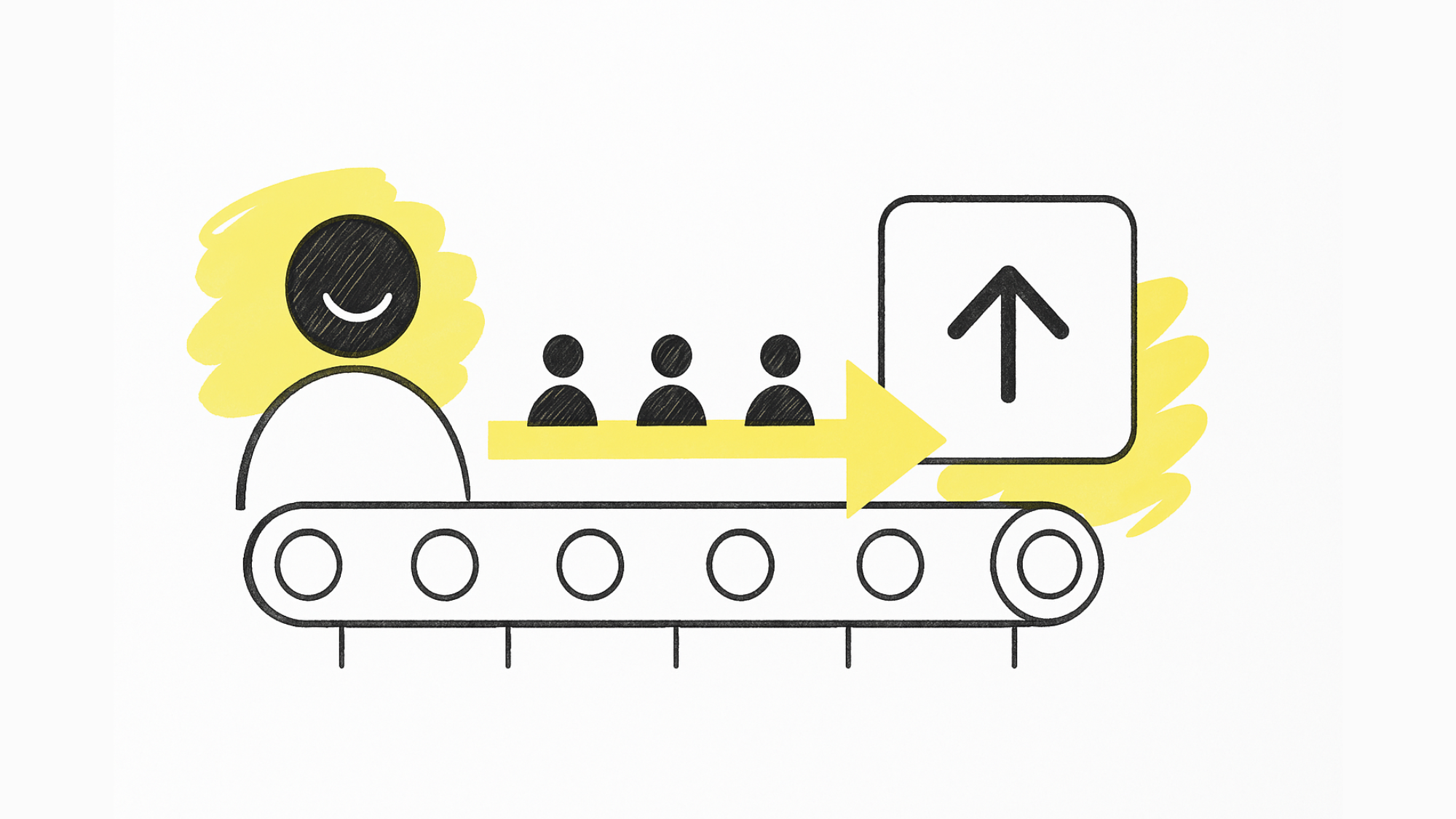
Acquisition is relatively easy. We live in an era where you can spin up campaigns across hundreds of channels and drive a steady flow of signups to your SaaS product. Throw enough money at the acquisition problem, and you can solve it.
Is it much more fragmented than in the past? Sure. But it’s trackable and somewhat predictable.
Activation, now that’s a completely different story. You can’t just throw money at that problem.
Think about the amount of time, effort, and human energy it takes just to get a new customer to the point where they actually see value in your product.
As your app gets more complex, that activation window doesn’t just expand a little; it grows almost exponentially.
And yet, whenever a brand wants to drive growth, the instinct is to dump more of its budget into acquisition.
More ads. More social shares. More blog posts. More signups. More “easy growth.”
What they don’t realize is that every new batch of users is adding onto an almost invisible backlog of work. At Quarterzip, we call that backlog activation debt.
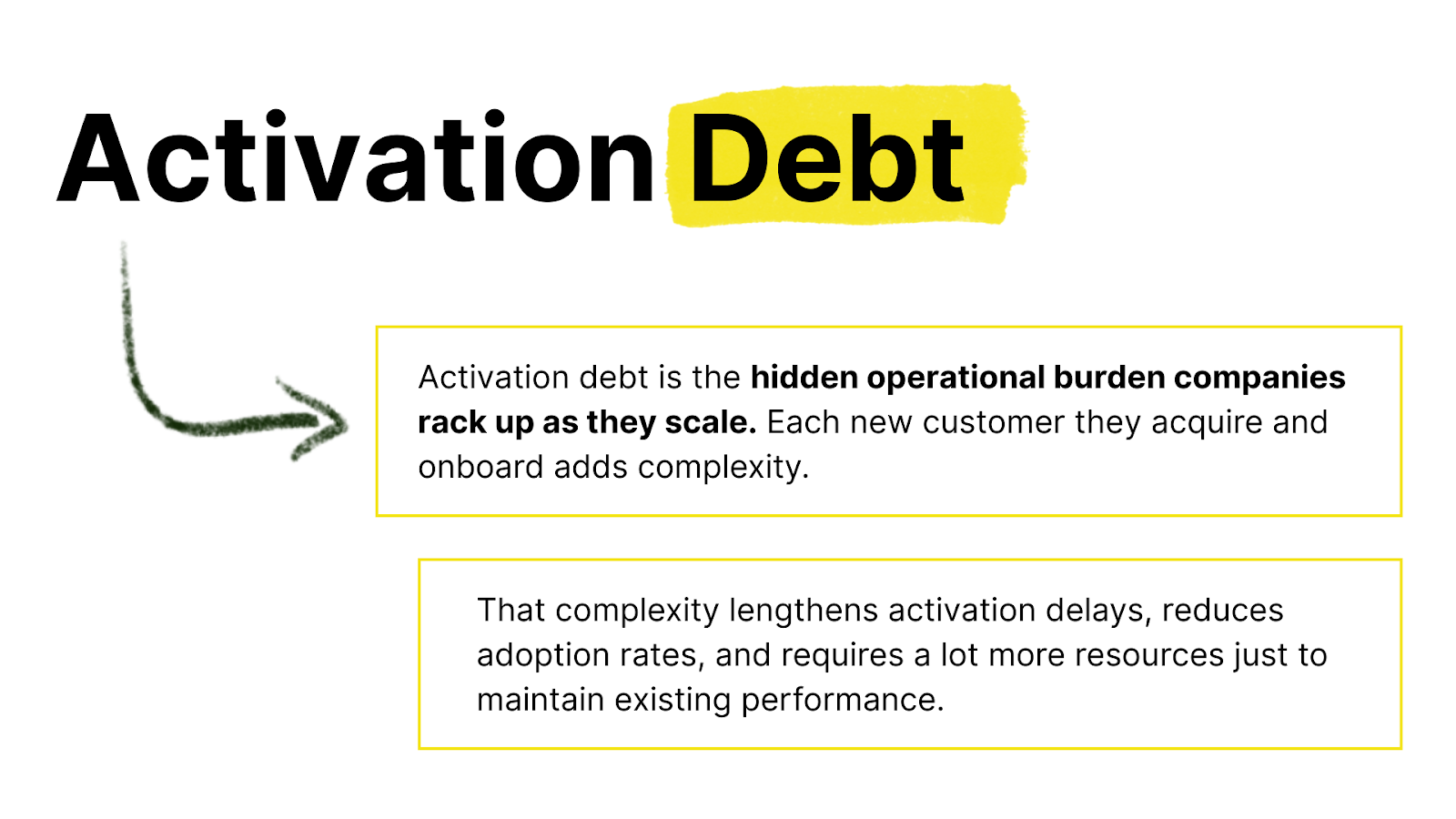
Activation debt is the hidden operational burden companies rack up as they scale. Each new customer they acquire and onboard adds complexity. That complexity lengthens activation delays, reduces adoption rates, and requires a lot more resources just to maintain existing performance.
Left unchecked, activation debt doesn’t just slow you down; it can completely stall growth. And here’s the hard truth: you can’t acquire your way out of activation debt.
And as new features ship faster than ever thanks to AI, and apps get even more complex but personalized to the user, that debt is only going to get more “expensive” to address.
But with continuous onboarding, you can start to fight back.
What is continuous onboarding?
Continuous onboarding isn’t a product tour or a monthly “what’s new” email. It’s an always-on onboarding strategy that adapts to each user’s journey and evolves with your product.
A new user doesn’t care about every feature you shipped last month. They care about getting to value as fast as possible. Continuous onboarding clears the path.
A month later, once they’ve built some momentum, they need nudges toward advanced workflows or integrations. Continuous onboarding can deliver that too, in context, at the moment it is useful.
And when new features roll out, they don’t get buried in an RSS feed. They show up for the right users at the right time.
Most teams' current onboarding flow simply can’t keep up. Every new release makes them a little more outdated, and before long, they’re completely out of sync with how the product is actually used. That’s when activation debt starts to pile up.
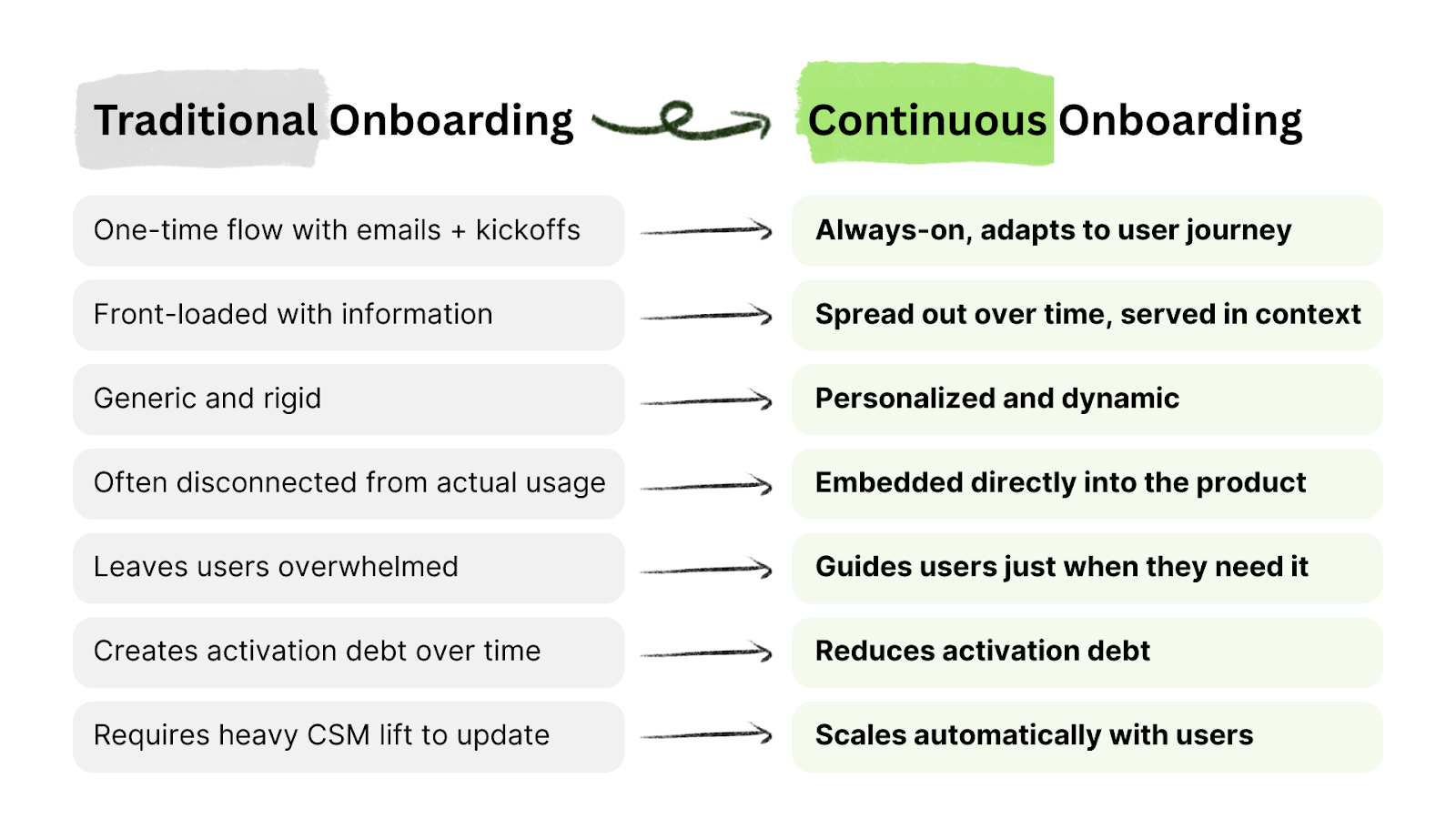
For fast-moving companies, onboarding can be obsolete the moment it goes live, further driving up their activation debt balance.
Continuous onboarding replaces email blasts with ongoing, in-product guidance. Instead of cramming everything into a week of popups or tooltips, you can spread customer education out over time and embed it into the product experience.
Customers learn as they go, without being overwhelmed, and without CSMs burning out constantly.
And once you start to embrace continuous onboarding, the impact is massive:
- Expanded and accelerated revenue - Personalized guidance shortens activation timelines and compresses time-to-value from months into days.
- Retention starts to improve - Continuous onboarding keeps customers engaged by surfacing new features and workflows when they’re ready for them.
- Scaling without headcount - Automating the repetitive work frees teams to focus on high-value touch points and accounts instead of running the same training calls all day.
- Your team learns more - Continuous onboarding shows you exactly where users lean in, where they drop off, and what needs fixing. That feedback loop makes the whole system smarter.
- Features actually get used - Instead of hoping users stumble into a new feature, guided flows can show them exactly how to use it at the right time.
Until recently, building this kind of system took a ton of manual work, which is why both PLG and sales-led companies stuck with static onboarding.
But with AI agents, personalization at this scale is finally possible. Every customer can have an always-on experience that reduces activation debt and keeps them finding value long after their first login.
And we are building that future at Quarterzip.
Continuous onboarding pays down activation debt
Just like tech debt, activation debt does not grow linearly; one new customer does not equal one unit of activation debt. Unfortunately, it grows a bit more chaotically depending on your company and industry.
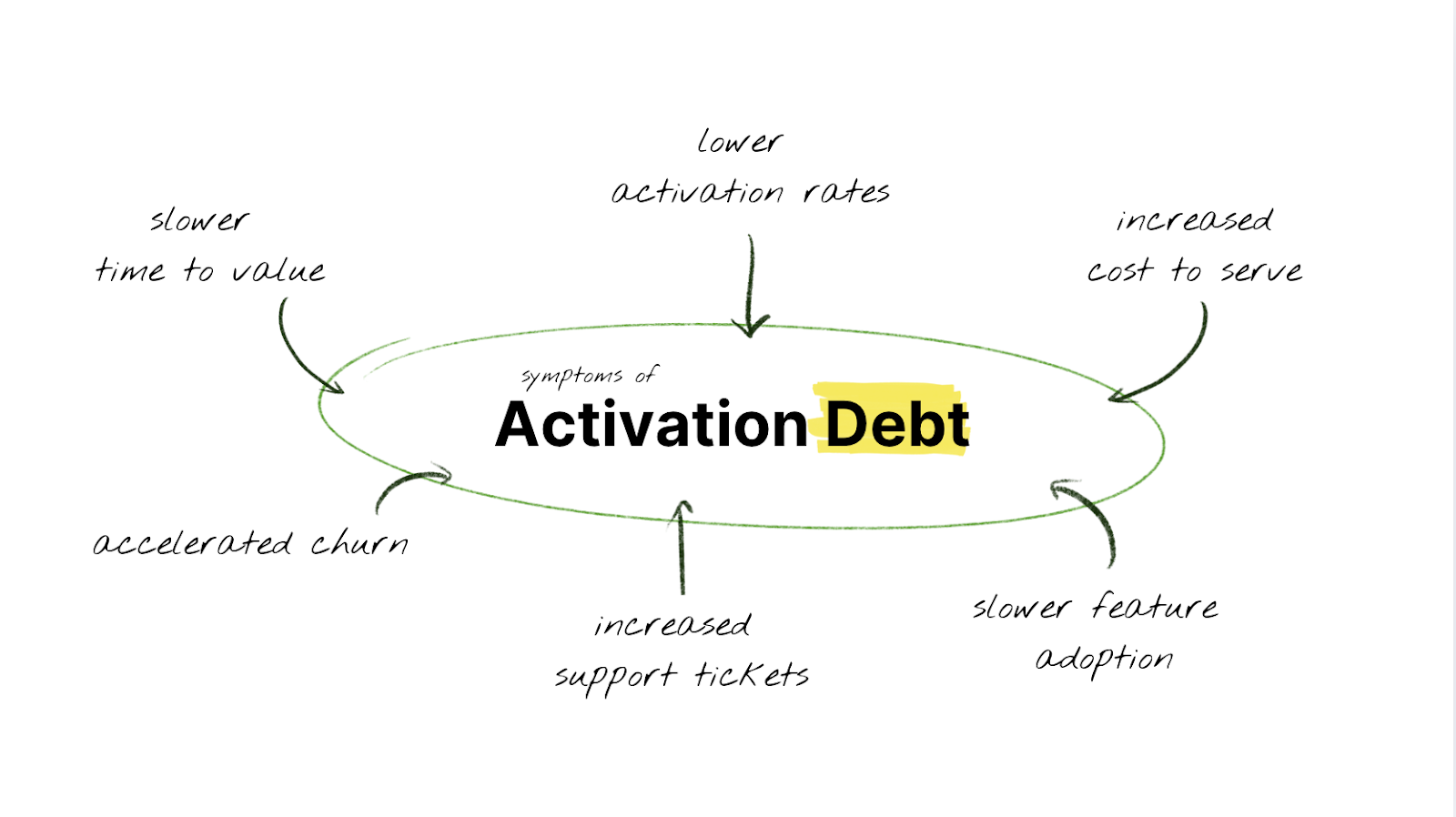
Some red flags make it obvious when activation debt is taking over:
- Poor activation & long time-to-value - users take too long to see value, slowing revenue and spiking early churn.
- High cost-to-serve - teams burn hours repeating the same kickoff calls.
- Accelerating churn - fragmented, inconsistent onboarding pushes customers away.
- Scaling inefficiency - CX headcount grows faster than the customer base.
- Fragmented experiences - users bounce between docs, emails, and popups that don’t align.
Most companies acquire activation debt the same way. Either by throwing people at the problem until onboarding turns into a patchwork of inconsistent experiences. Or more often than not, in PLG companies, by relying on generic tours and email drips because they can’t hire enough people to cover thousands of users.
In both cases, the result is the same. It starts with stalled activation, followed by lagging adoption or expansion, and then your exciting growth screeches to a halt.
Continuous onboarding breaks that cycle. It replaces kickoffs and drip campaigns with role-aware steps in the product itself. The very problems that hold users back are transformed into actions that push them forward at speed:
- Personalized in-product guidance gets each role to value faster. Activation climbs and time to value drops from weeks to days, or even hours.
- Automating repetitive onboarding tasks removes the busywork. Onboarding hours per account fall, and new-customer tickets drop like a rock.
- Continuous onboarding keeps people engaged after day one. More customers are active at day 30, while your new features are adopted faster.
- Growth that doesn’t require growing headcount gives you leverage. The same team supports more accounts and focuses on outcomes instead of more kickoff calls.
- One consistent flow inside the product replaces scattered docs and emails. More people finish onboarding, more of them activate, and the biggest drop-off points shrink.
When onboarding shifts from a kickoff event to a continuous system, you start to pay down the balance. More users reach value, more features stick, and teams spend less time on setup calls and more time driving real outcomes.
Why we are building better onboarding
The truth is that onboarding hasn’t changed significantly in almost a decade. The same playbooks that helped Slack scale users in 2015 are still being dragged out today, even though the way we build and buy software has completely shifted. And dudes in quarterzips are spending an hour, or five, telling you how to use their software as part of some stellar post-sales support.
For most PLG companies, onboarding looks similar: sign up, click through a few tooltips, maybe watch a quick video, then get buried in a drip of onboarding emails. A week later, the flow ends, and teams call that user “activated.”
Now this might feel pretty impersonal, rigid, and prone to user frustration, and that’s because it is. But that’s the point, you can’t outline every feature or use case your company offers in onboarding. So they opt for the most cleanly defined cases.
The sales-led alternative isn’t much better. You can hire CSMs to walk customers through the product one by one, but that scales linearly with headcount.
The onboarding and service may be a lot more personalized, but there are only so many CSMs that you can hire before the unit economics break down.
We talked to teams where CSMs were doing nine identical training calls a day. They weren’t helping customers unlock new value or learn how to use the product. They were just repeating the same script, bored out of their minds.
Obviously, neither approach actually provides the customer with the white glove experience they deserve, especially as a company continues to scale.
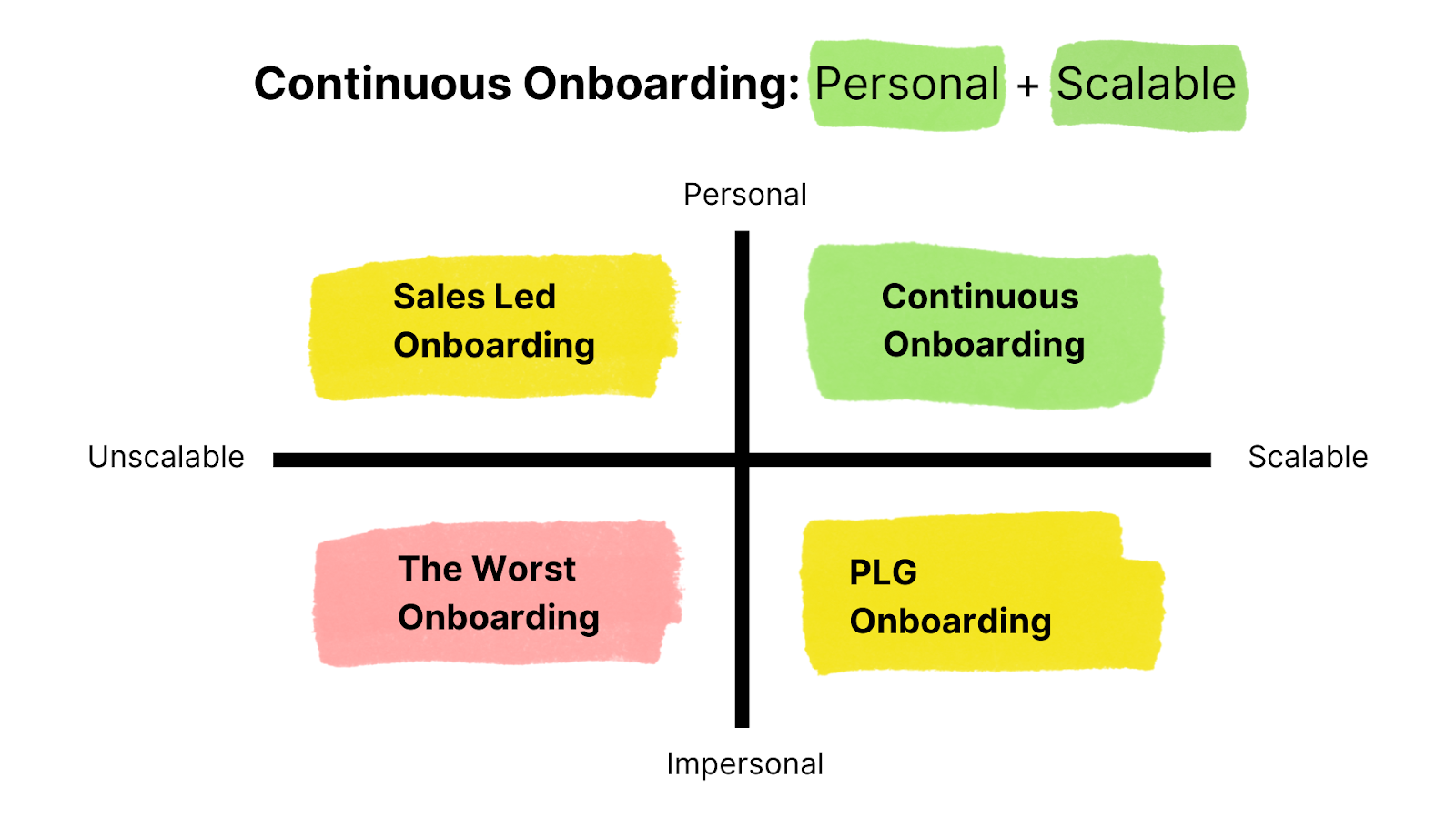
And the result is the same: most users never actually activate. Companies told us 95% of sign-ups never speak to a human, and only about 30% end up truly activated.
That’s why we’re building Quarterzip. Because every time a new user slips through the cracks, you’re adding to your activation debt. And that debt doesn’t exist in a vacuum; it quickly eats into growth.
We’ve seen the flip side, too. Brands adopt continuous onboarding, users actually activate, and everything gets easier.
And the results from our beta customers speak for themselves:
- Reduced onboarding time by 70%
- Increased user activation rates by 35% within the first 30 days
- Improved customer retention by 25% year-over-year
This isn’t about tinkering with tooltips or sending a fresher batch of onboarding emails.
Continuous onboarding is all about building an entirely new way to guide users that adapts to them, scales with your product, and actually compounds value over time.
Supercharge your post sales teams

